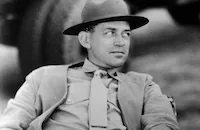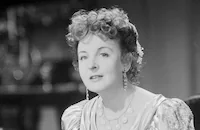Tarzan, the Ape Man

Brief Synopsis
Cast & Crew
W. S. Van Dyke
Johnny Weissmuller
Neil Hamilton
C. Aubrey Smith
Maureen O'sullivan
Doris Lloyd
Film Details
Technical Specs

Synopsis
English trader James Parker and his partner, Harry Holt, are about to embark on a journey beyond the Mutia Escarpment, where a fabled ivory-rich elephants' graveyard lies, when James's daughter Jane arrives from England. After a tearful reunion with her father, Jane, who says she is "through with civilization" and prefers to be a savage, insists on joining the expedition on its dangerous trek in search of an ivory deposit worth eleven million dollars. Though James is reluctant to let his daughter accompany them, he eventually allows her to go when a smitten Harry sides with her. Before they leave, James tells his daughter about the legend surrounding the burial site, and warns her that the natives consider the place sacred and taboo and that all who so much as look at it are put to death by tribal witchmen.
James's account of the legend soon proves true when a native, crazy with fear after having seen the burial ground, runs into their camp to take refuge from the brutal Ubangi tribe and then mysteriously dies. When the expedition party finally arrives at the wall of the Mutia Escarpment, they are forced to scale its narrow precipice, which proves too narrow for one of the men, who falls to his death. Jane also loses her footing, but she is pulled back by a rope. After coming to a resting point, the expedition party is bewildered by an ape call they hear in the distance that is distinctly human-like. They soon meet the source of the sound when Tarzan uses his jungle call to save them from an attack by threatening hippopotami. Tarzan, who understands no language, then carries the screaming Jane to his treetop home, where she gradually loses her fear of him and the apes who live in the trees. Later, while Tarzan has left Jane to search for food, Harry and James rescue her, but not before Harry shoots an ape that he believes is a threat to Jane.
Tarzan witnesses the killing and follows the expedition to take revenge on them. After drowning one of James's African guides, Tarzan recaptures Jane and then, with the help of an elephant, engages an attacking lion in a fight. The elephant carries the defeated and unconscious Tarzan to safety and then calls Tarzan's apes to summon Jane. Jane arrives in time to bandage the wounded ape man, and the two share a romantic swim in a nearby river. Later, from her treetop vantage point, Jane sees her ailing father fall down and decides that she must go to him. Tarzan, hurt by Jane's departure, flees into the jungle. Soon after he leaves, the expedition is surrounded by a large number of pygmies, who abduct the hunters and take them downriver to their camp. Along the way, Jane sees Cheetah, Tarzan's chimpanzee friend, and sends the animal for help.
While the pygmies make a cruel game out of sacrificing Harry, James and Jane to a ferocious beast in a pit, Tarzan arrives with a herd of elephants, and Jane and her party are freed. Jane, her father, Tarzan and Harry ride away from the camp on the backs of elephants, and though James discovers that his elephant is dying, he insists on staying on him in the hope that the animal will lead him to the sacred burial site. The elephant leads James to the site, but as soon as he sets his eyes on the grave, he dies. After saying goodbye to Harry, Jane is reunited with Tarzan and Cheetah and remains with them.

Director

W. S. Van Dyke
Cast

Johnny Weissmuller

Neil Hamilton

C. Aubrey Smith

Maureen O'sullivan

Doris Lloyd
Forrester Harvey
Ivory Williams
Crew
Steve Bauder
Clyde De Vinna
Cedric Gibbons
Nick Grinde
Tom Held
Cyril Hume
Ben Lewis
Paul Neal
Bert Nelson
Ivor Novello
Arthur Rose
Harold Rosson
Douglas Shearer

Photo Collections
Videos
Movie Clip



Trailer
Hosted Intro
Film Details
Technical Specs

Articles
Tarzan, the Ape Man (1932)
Originally, MGM executives planned to feature Tarzan in a sequel to their popular 1931 adventure Trader Horn, the first sound film to feature extensive location footage shot in Africa. In fact, the studio had so much location footage left over after making Trader Horn that they were looking for another story that would let them use it. Tarzan author Edgar Rice Burroughs' general manager suggested teaming the heroic Trader Horn with Tarzan, so MGM picked up the rights. Then they decided to focus on Tarzan alone.
The studio considered several candidates for the title role, including Clark Gable, Joel McCrea, Charles Bickford and two future Tarzans, Olympic swimming champion Buster Crabbe and the gold-medallist in the shot put, Herman Brix (later known as Bruce Bennett). Then they found Weissmuller. The swimming star had won five gold medals in the 1924 and 1928 Olympics, in addition to 67 world and 52 national titles. He had broken 174 individual records, including every freestyle record from the 100 yards to the half-mile. There was only one problem. He was under exclusive contract to model BVD underwear. To win Weissmuller's release, MGM had to work out a deal for their top stars - from Greta Garbo to Marie Dressler - to appear in BVD ads.
For a while, it was just as hard to cast Tarzan's mate, Jane. They couldn't find anybody with the right combination of sophistication and innocence until casting received a photo of a young Irish actress named Maureen O'Sullivan. They immediately signed her to a long-term contract, and she made her MGM debut in Tarzan, the Ape Man.
The stock footage was added to location work shot in the then-undeveloped Toluca Lake region north of Los Angeles, where the only delay was caused when two trained rhinos being used in the film were given a bath in the lake and refused to leave. Sound technicians created the famed Tarzan yell by amplifying and repeating Weissmuller's voice. They even played parts of his yell backwards to get the right effect. The result was so distinctive it turned up in Tarzan films for almost 50 years.
Tarzan, the Ape Man was a huge hit, bringing in almost $1 million in profits, leading MGM to feature Weissmuller and O'Sullivan in five sequels. Ironically, Edgar Rice Burroughs, the character's creator, was not happy with the MGM version, which turned his cultured British lord of the jungle into a monosyllabic ape man. Others have derided the film for its depiction of native Africans as bloodthirsty savages, its cheesy man-in-a-gorilla suit monster and the rampant sexuality of Tarzan's relationship with Jane, which was frowned upon by religious groups. Yet, if anything, these are all part of the mix that has made the film an enduring classic.
Producer: Irving G. Thalberg
Director: W.S. Van Dyke II
Screenplay: Cyril Hume, Ivor Novello
Based on characters created by Edgar Rice Burroughs
Cinematography: Harold Rosson, Clyde De Vinna
Art Direction: Cedric Gibbons
Music: Georges Richelavie
Cast: Johnny Weissmuller (Tarzan), Neil Hamilton (Harry Holt), Maureen O'Sullivan (Jane Parker), C. Aubrey Smith (James Parker), Doris Lloyd (Mrs. Cutten), Forrester Harvey (Beamish), Johnny Eck (Bird creature).
BW-101m. Closed captioning. Descriptive Video.
by Frank Miller

Tarzan, the Ape Man (1932)
Quotes
Trivia
When 'Johnny Weismuller' was approached to play Tarzan, he was under contract with BVD to advertise their underwear and swimming trunks. BVD strenuously objected to their spokesman appearing in just a loincloth - they only wanted him to appear wearing their product. In return for letting Weismuller play Tarzan, MGM allowed BVD to run ads featuring their contract players in BVD swimsuits (including Greta Garbo, Joan Crawford, Jean Harlow and Marie Dressler). (source: Tarzan of the Movies by Gabe Esso)
Tarzan's distinctive call was created by sound recordist Douglas Shearer. It was a normal call, manipulated and played backwards.
Notes
This picture was M-G-M's first Tarzan film. It was also the first full-length sound Tarzan feature, and the first to star Johnny Weissmuller, a two-time Olympic swimming champion, as Tarzan. According to modern sources, Weissmuller was chosen to play Tarzan despite the objections of Burroughs. Weissmuller is the longest lasting Tarzan to date, having portrayed the apeman in twelve feature films from 1932-1948. According to M-G-M studio records, the film cost $652,675 to make. The Variety review of the film, which erroneously listed a running time of seventy minutes, noted M-G-M's success in finding fifty dwarfs to play pygmies in the picture. Contemporary sources indicate that some film footage from director Van Dyke's earlier African adventure film, Trader Horn (see below), was included in the film. New York Times news items note that the exterior sequences were filmed in western Mexico and at Sherwood Forest, CA. According to Hollywood Reporter, filming also took place at Sherwood Lake, which May have been located at Sherwood Forest. A November 1939 Hollywood Reporter news item notes that Nick Grinde was in charge of the second unit filming of "limb-to-limb jumpers and pygmies." According to a New York Times article about production difficulties encountered by the film crew, a near-tragedy occurred when a hippopotamus charged at a makeshift reflecting wall supported by crewmen. Hollywood Reporter indicates that second cameraman Steve Bauder narrowly escaped serious injury when a lion attacked him and broke his camera.
Modern sources note that the Mutia Escarpment, Tarzan's fictional jungle domain, was named after Mutia Omoolu, the African actor who played Aloysius Horn's gun bearer in Trader Horn. Modern sources provide the following additional credits: Irving Thalberg, executive producer; Bernard H. Hyman, line producer; J. J. Cohn, production manager; George Emerson, Louis Roth and Louis Goebel, animal supervision; Warren Newcombe, photographic effects; William Snyder, additional cinematography; George Richelavie, Fritz Stahlberg and Paul Marquardt, music; Dunning Process Company and Williams Composite Laboratories, composite effects; aerialist Alfredo Codona, Weissmuller's double for swinging shots; and Emma, the chimp as "Cheetah." According to a biography of Edgar Rice Burroughs, M-G-M originally opted for Stanford University star weight-lifter Herman Brix (who later played the role in the Burroughs-Tarzan series) to play Tarzan, but he was replaced following an injury he sustained while filming Touchdown (see below), his first film. The Burroughs biography also notes that the film's scheduled March 1932 opening was postponed due to the national attention devoted to the Lindbergh kidnapping. M-G-M reportedly paid Burroughs $20,000 plus a $1,000 weekly salary in exchange for the rights to all the characters used in previously written Tarzan stories. According to a 1961 Variety article, a Superior Court judge "sustained a demurrer made by M-G-M in a suit brought against [the] studio by Edgar Rice Burroughs, Inc. over the remake of its original Tarzan of the Apes, and found in favor of the studio that it had not breached a 1931 contract." The contract stipulated that the studio could film a remake of this story only if no substantial changes were made. Burroughs' suit followed M-G-M's 1959 remake of Tarzan, the Ape Man, which he claimed to be an altered version of the original story. Judge Frank S. Balthis ruled against Burroughs, stating that the remake was "substantially the same as the original" and that the studio was not in breach of contract. According to Burroughs' biography, producer, exhibitor and showman Sol Lesser claimed that before Tarzan, the Ape Man was released, he had purchased the rights to film a Tarzan picture from James Pierce, who had been given the rights by Burroughs as a marriage gift when he married Burroughs' daughter. Unaware that Burroughs had already sold the rights to M-G-M, Lesser's lawyer, Jules Goldstone, handed the author $10,000 in cash for the rights, at which point Burroughs informed him that Pierce's contract had lapsed. Burroughs reportedly "threw the money back." The biography also notes that "it was a windy day and Mr. Goldstone had quite a time chasing after the bills." Following this, Lesser filed a suit and left it to the courts to decide if his contract was valid. In the meantime, Lesser agreed to postpone production on his Tarzan picture until M-G-M released Tarzan, the Ape Man. Lesser, Burroughs and M-G-M eventually settled the matter, and M-G-M went ahead with preparations for its next Tarzan picture while Lesser planned to film five Tarzan pictures.
Two M-G-M remakes of Tarzan, the Ape Man followed its release: a 1959 film directed by Joseph M. Newman and starring Dennis Miller and Joanna Barnes (which contained tinted stock footage from the 1932 version); and a 1981 film directed by John Derek and starring Bo Derek and Richard Harris. According to an 1981 article in the Los Angeles Herald Examiner, Maureen O'Sullivan refused to view the 1981 remake because the reviews she had read of the film suggested that it exploited sex and nudity. O'Sullivan stated that the 1932 version of the film contained "poetic sex," and that the remake might "detract from the innocence of the story." Derek's 1981 remake also encountered legal entanglements concerning the rights to the Tarzan story when the Burroughs estate sued M-G-M over the picture. The issue was finally resolved in 1982, when, according to Hollywood Reporter, the Court of Appeals ruled that "differences between the works overwhelm this general similarity [to the film]," and therefore did not constitute an act of copyright infringement. Furthermore, the judge ruled that the 1981 version did not materially depart from the 1932 movie even though the 1981 film contained two nude scenes.
Other films or television programs based on the characters created by Burroughs include: the 1918 First National film Tarzan of the Apes, directed by Scott Sidney and starring Elmo Lincoln and Enid Markey (see AFI Catalog of Feature Films, 1911-20; F1.4370); the 1923 Nation Film Corp. picture Jungle Trail of the Son of Tarzan, directed by Harry Revier and Arthur Flaven (see AFI Catalog of Feature Films, 1921-30; F2.2827); the 1942 M-G-M film Tarzan's New York Adventure, directed by Richard Thorpe and starring Johnny Weissmuller and Maureen O'Sullivan; the 1958 M-G-M film Tarzan's Fight for Life, directed by H. Bruce Humberstone and starring Gordon Scott and Eve Brent; the 1966 Banner Productions-Allfin U.S./Switzerland co-production Tarzan and the Valley of Gold, directed by Robert Day and starring former L. A. Ram lineman Mike Henry and Nancy Novak (see AFI Catalog of Feature Films, 1961-70; F6.4884); the 1966-1968 NBC television series Tarzan, made by Banner Productions and starring Ron Ely; the animated half-hour CBS television network series Tarzan-Lord of the Jungle, which had its premiere on September 11, 1976; the 1989 American First Run Studios telefilm Tarzan in Manhattan, directed by Michael Shultz and starring Joe Lara and Kim Crosby, which aired on the CBS television network on April 15, 1989; and the 1999 animated Disney release, directed by Chris Buck and Kevin Lima and featuring the voices of Tony Goldwyn and Minnie Driver. For titles of Tarzan films made in the 1930s, consult the Series Index.
















